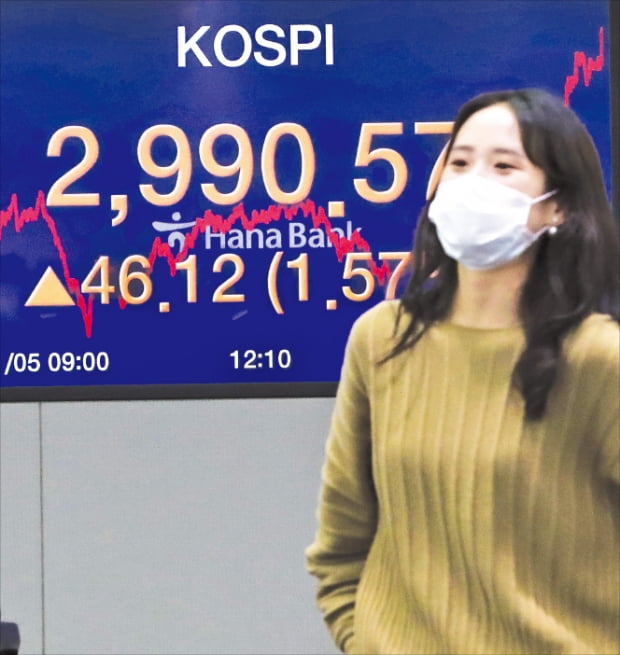
The stock price is close to 3000. On the 5th, the KOSPI index rose 1.57% to 2990.57. The photo shows Hana Bank’s dealing room in Jung-gu, Seoul right after the market closes. News 1
The KOSPI index 3000 came to the fore. From 2200, I ran without any adjustments. Some say, “I’m afraid, it’s overheating.” On the other side, “the stock market is in the process of leveling up, the liquidity is still abundant.” Even in the new year, individual investors are turning their direction by appearing without fail if the stock price falls.
I was curious. How far has this flow come and how far will it go? Last year, I asked Samsung Securities, who accurately predicted the flow of the market with the word’money move’. Sa Jae-hoon, head of Channel Sales Division, who oversees sales for individuals and corporations at Samsung Securities, answered the question.
500% increase in 1980s
Last year, the KOSPI index rose 30.75%. This is the result of individuals buying more than 47 trillion won worth. Its strength did not weaken in the new year. On the 5th, the KOSPI index ended at 2990.57, up 1.57%. Even on this day, the staggering market turned red with an individual buying more than 700 billion won. The combined trading value of the securities and KOSDAQ market reached a record high of 45 trillion won.

The first anxiety caused by such a surge in stock prices is that prices are too high. The 12-month lead price-earnings ratio (PER) exceeded 14x. It is the highest since 2007. Regarding the overvaluation controversy, the head of the private sector said, “In the original liquidity market, the overheating and overheating controversy grows and rises.” It means that the stock price will continue to rise. As a basis, data comparing the past liquidity rally and the present were presented. There was a liquidity rally from 1985 to 1989.
‘Fire ants market’ in the past
In the mid-1980s, Korea faced a’third low boom’ with low interest rates, low dollars and low oil prices. This led to a liquidity rally. Share price rise was led by individuals. It was a time when foreigners could not freely trade Korean stocks.
At the end of 1985, the stock index was 163.37. It started to skyrocket at this time and recorded 272.61 at the end of 1986. It soared to 909.72 at the end of 1989. The rate of increase over 4 years was 525%. The number of individual investors increased 25 times from 75,4363 at the end of 1985 to 1896,8277 at the end of 1989. “The increase of 6 million accounts in Korea last year is similar to that in the 1980s,” the head of the company said.
There is another thing in common. Even then, there was a controversy over high evaluation. The stock market PE soared from 5.2x in 1985 to 10.9x in 1987 and 13.9x in 1989. On the other hand, the growth rate of manufacturing sales increased from 9.8% in 1985 to 22.6% in 1987, but fell to 15.8% in 1988 and declined to 7% in 1989. It was a liquidity market that rose with the power of money rather than performance.
American rally in the 1990s
The head of the company also cited the US stock price rise in the 1990s as an example. The US stock market started rising in 1991. In 1996, Alan Greenspan, then the chairman of the US Central Bank (Fed), warned that it was’irrational overheating’. But after the warning, the US market rose three more years. The NASDAQ index increased by 3 times, and the PER exceeded 100 times at the time.
“Looking at the past liquidity rally, it is impatient to worry about overheating and overvaluing over the eight-month-long rise,” he said. The US Fed has announced that it will not raise interest rates until 2023, and if economic activity normalizes due to the spread of the Corona 19 vaccine, it is predicted that there is a possibility that the global stock market will rise as much as last year due to liquidity and performance.
Increasing stock supply and interest rates
That doesn’t mean the stock price can’t rise endlessly. The head of the private sector suggested two factors that are disrupting the liquidity market. “Excessive stock supply or government liquidity recovery can stop the market,” he said. At the end of the 1980s, it collapsed due to excessive stock supply. At the end of 1988, the market capitalization of the entire market was 66 trillion won. The following year, when the stock price rose, the IPO and capital increase amounted to 14 trillion won. Stock prices have stopped rising. Although IPOs have recently boomed, the situation is different. The market capitalization was close to 2,000 trillion won last year, but the total amount of IPO and capital increase was 7 trillion won. “It seems difficult for the central bank to raise interest rates in both the US and Korea for the time being, but we need to closely monitor the rate hike and the surge in stock supply.”
As for the investment strategy, he said that it is necessary to find a new leader. He said, “Even during the 1980s rally, troika stocks such as banking and securities construction led the rise,” he said. “Along with the stocks that were the leading stocks last year, contact stocks and economically sensitive stocks that are likely to become new leaders should be brought into the portfolio.” Along with this, he added that indirect investment products such as wraps, funds, and ETFs should be turned into focus.
Reporter Park Uimyung [email protected]
